Σκοπιανό
Ολόκληρη η Συνθήκη Βουκουρεστίου 1913 – πουθενά ο όρος «Μακεδονία»! ψεύδη τα ποσοστά…

Αυτό δεν λένε;
Το λέει ο (τέως) υπουργός εξωτερικών Νίκος Κοτζιάς, το λέει ο πρωθυπουργός Αλέξης Τσίπρας (μαζί με την Μπακογιάννη και τον Μπουτάρη), το λέει ο Τζανακόπουλος, το λένε υπουργοί του ΣΥΡΙΖΑ (εδώ και εδώ), το λέει ο Ριζοσπάστης, το λέει ο 902, o Μπογιόπουλος, το λέει το ΚΚΕ στα φυλλάδια που μοιράζει στα σχολεία (φωτο 1, φωτο 2, φωτο 3), το λέει η Εφημερίδα των Συντακτών, to Documento, το λέει ο Μαυρίδης του liberal.gr, το λέει η Καθημερινή (ως εφημερίδα), το γράφει σε blog του Πρώτου Θέματος, το λένε καθηγητές πανεπιστημίου (στην Αυγή, στο Στο Κόκκινο, στο Κουτί της Πανδώρας), το γράφουν στα ελληνικά πανεπιστήμια (Μάστερ στο Παν. Μακεδονίας), το λέει η εγγονή του Τίτο, διάφοροι (εδώ, εδώ, εδώ, εδώ, εδώ). Το λέει εμμέσως και ο υπ. εξ. των Σκοπίων Δημητρώφ. Το λένε λίγο-πολύ όλοι.
Εμείς, στο Αντίβαρο, το αμφισβητούμε. Το ίδιο κάνουν και οι εξής: ο Σάββας Καλεντερίδης, ο Γιώργος Ρωμανός, οι Ακτίνες, οι Χρονογραφίες, και άλλοι.
Παραθέτουμε ολόκληρη την Συνθήκη Ειρήνης του Βουκουρεστίου στα ελληνικά (από τον ιστοχώρο του ΓΕΕΘΑ). Στον ακόλουθο σύνδεσμο θα την βρείτε και στα αγγλικά (στο scribd). Κατεβάστε την στα ελληνικά από εδώ
- ψεύδος ότι η Συνθήκη του Βουκουρεστίου αναφέρεται στην Μακεδονία
- ψεύδος ότι η Συνθήκη του Βουκουρεστίου μοίρασε την Μακεδονία σε 3 ή 4 χώρες
- ψεύδη τα ποσοστά που αναφέρονται συνήθως
- ψεύδος ότι η περιοχή της πΓΔΜ ανήκει σε κάποια έννοια μίας ευρείας περιοχής της Μακεδονίας. Ουδέποτε υπήρξε τέτοια διοικητική περιοχή επί Οθωμανικής Αυτοκρατορίας. Έναν χάρτη με Οθωμανική διοίκηση περί «Μακεδονίας» δεν έχουν βρει ακόμη.
- μόνο το πολύ νότιο τμήμα της πΓΔΜ, δηλαδή η περιοχή γύρω από το Μοναστήρι και τις πόλεις Αχρίδα, Αντιγόνεια, Δίβρη και Άστιβος. Μόνο αυτές οι πόλεις, οι οποίες μάλιστα φέρουν και ελληνικά ονόματα, ανήκαν στην περιοχή της Μακεδονίας. Σημειώνεται ότι βάσει της Συμφωνίας των Πρεσπών, υποχρεωνόμαστε να παύσουμε να χρησιμοποιούμε τα ελληνικά ονόματα γι’ αυτές τις πόλεις! Θα πρέπει να χρησιμοποιούμε τα «μακεδονικά» (κατά την Συμφωνία) ονόματα, δηλαδή Μπίτολα, Οχρίντ, Νεγκότινο, Ντέμπαρ, Στιπ.
- Η Ελλάδα από το 1912-13 που απελευθέρωσε τα εδάφη της Μακεδονίας, αμέσως τα ονόμασε επισήμως Μακεδονία, όπως και ήταν. Η Γιουγκοσλαβία για 30 χρόνια δεν χρησιμοποιούσε αυτό το όνομα. Μόνο το 1943-44 άρχισε να το χρησιμοποιεί. Η Βουλγαρία δε καθόλου, ούτε και σήμερα.
Peace Treaty between Roumania, Greece, Montenegro, Serbia and Bulgaria.THEIR MAJESTIES the King of Roumania, the King of the Hellenes, the King of Montenegro, and the King of Serbia, on the one part, and His Majesty the King of the Bulgarians, on the other part, animated by the desire to put an end to the state of war at present existing between their respective countries and wishing, for the sake of order, to establish peace between their long-suffering peoples, have resolved to conclude a definitive treaty of peace. Their said Majesties have, therefore, appointed as their plenipotentiaries, namely:His Majesty the King of Roumania: His Excellency Titus Maioresco, President of his Council of Ministers, Minister of Foreign Affairs; His Excellency Alexander Marghiloman, his Minister of Finance; His Excellency Take Jonesco, his Minister of the Interior; His Excellency Constantin G. Dissesco, his Minister of Public Worship and Public Instruction; Major-General C. Coanda, Aide-de-camp, Inspector-General of Artillery; Colonel C. Christesco, Assistant Chief of the General Staff of his Army;His Majesty the King of the Hellenes: His Excellency Elefterios Venizelos, President of his Council of Ministers, Minister of War; His Excellency Demetre Panas, Minister Plenipotentiary; M. Nicolas Politis, Professor of International Law in the University of Paris; Captain Ath. Exadactylos; Captain C. Pali;His Majesty the King of Montenegro: His Excellency General Serdar Yanko Voukotitch, President of his Council of Ministers, Minister of War; M. Jean Matanovitch, formerly Charge d’Affaires of Montenegro at Constantinople;His Majesty the King of Serbia: His Excellency Nicolas P. Pasitch, President of his Council of Ministers, Minister of Foreign Affairs; His Excellency Milhailo G. Ristitch, his Envoy Extraordinary and Minister Plenipotentiary at Bucharest; His Excellency Dr. Miroslaw Spalaikovitch, Envoy Extraordinary and Minister Plenipotentiary; Colonel K. Smilianitch; Lieutenant-Colonel D. Kalafatovitch;His Majesty the King of the Bulgarians: His Excellency Dimitri Tontcheff, his Minister of Finances; Major-General Ivan Fitcheff, Chief of Staff of his Army; M. Sawa Ivantchoff, Doctor of Laws, formerly Vice-President of the Sobranje; M. Simeon Radeff; Lieutenant-Colonel Constantin Stancioff of the General Staff;Who, in accordance with the proposal of the Royal Government of Roumania, have assembled in conference at Bucharest, with full powers, which were found to be in good and due form, and who having happily reached an accord, have agreed upon the following stipulations:-I.From the day on which the ratifications of the present treaty are exchanged there shall be peace and amity between His Majesty the King of Roumania, His Majesty the King of the Bulgarians, His Majesty the King of the Hellenes, His Majesty the King of Montenegro, and His Majesty the King of Serbia, as well as between their heirs and successors, their respective States and subjects.II.The former frontier between the Kingdom of Bulgaria and the Kingdom of Roumania, from the Danube to the Black Sea, is, in conformity with the proces-verbal drawn up by the respective military delegates and annexed to Protocol No.5 of July 22 (August 4), 1913, of the Conference of Bucharest, rectified in the following manner:-The new frontier shall begin at the Danube above Turtukaia and terminate at the Black Sea to the south of Ekrene.Between these two extreme points the frontier line shall follow the line indicated on the I/ 100,000 and I/200,000 maps of the Roumanian General Staff, and according to the description annexed to the present article.It is formally understood that within a maximum delay of two years Bulgaria shall dismantle the existing fortifications and shall not construct others at Rustchuk, at Shumla, in the intervening country, and in a zone of twenty kilometres around Baltchik.A mixed commission, composed of an equal number of representatives of each of the two High Contracting Parties, shall be charged, within fifteen days from the signing of the present treaty, with delimiting the new frontier in conformity with the preceding stipulations. This commission shall supervise the division of the lands and funds which up to the present time may have belonged in common to districts, communes, or communities separated by the new frontier. In case of disagreement as to the line or as to the method of marking it, the two High Contracting Parties agree to request a friendly Government to appoint an arbitrator, whose decision upon the points at issue shall be considered final.III.The frontier between the Kingdom of Bulgaria and the Kingdom of Serbia shall follow, conformably to the proces-verbal drawn up by the respective military delegates, which is annexed to Protocol No.9 of July 25 (August 7), 1913, of the Conference of Bucharest, the following line:-The frontier line shall begin at the old frontier, from the summit of Patarica, follow the old Turco-Bulgarian frontier and the dividing line of the waters between the Vardar and the Struma, with the exception of the upper valley of the Strumitza, which shall remain Serbian territory; the line shall terminate at the Belasica Mountain, where it will bend back to the Greco-Bulgarian frontier. A detailed description of this frontier and the I/200,000 map of the Austrian General Staff, on which it is indicated, are annexed to the present article.A mixed commission, composed of an equal number of representatives of each of the two High Contracting Powers, shall be charged, within fifteen days from the signing of the present treaty, with delimiting the new frontier, in conformity with the preceding stipulation.This commission shall supervise the division of the lands and funds, which up to the present time may have belonged in common to the districts, communes, or communities separated by the new frontier. In case of disagreement as to the line or as to the method of marking it, the two High Contracting Parties agree to request a friendly Government to appoint an arbitrator, whose decision upon the points at issue shall be considered final.IV.Questions relating to the old Serbo-Bulgarian frontier shall be settled according to the understanding reached by the two High Contracting Parties, as stated in the protocol annexed to the present article.V.The frontier between the Kingdom of Greece and the Kingdom of Bulgaria shall follow, conformably to the proces-verbal drawn up by the respective military delegates and annexed to Protocol No.9 of July 25 (August 7), 1913, of the Conference of Bucharest, the following line:-The frontier line shall start from the new Serbo-Bulgarian frontier on the summit of Belasica Planina and terminate at the mouth of the Mesta on the Aegean Sea.Between these two extreme points the frontier line shall follow the line indicated on the I/200,000 map of the Austrian General Staff, in accordance with the description annexed to the present article.A mixed commission, composed of an equal number of representatives of each of the two High Contracting Parties, shall be charged, within fifteen days from the signing of the present treaty, with delimiting the frontier in conformity with the preceding stipulations.This commission shall supervise the division of the lands and funds, which up to the present time may have belonged in common to the districts, communes, or communities separated by the new frontier. In case of disagreement as to the line or as to the method of marking it, the two High Contracting Parties engage to request a friendly Government to appoint an arbitrator, whose decision upon the points at issue shall be considered final.It is formally understood that Bulgaria renounces from henceforth all claim to the island of Crete.VI.The headquarters of the respective armies shall be immediately informed of the signing of the present treaty. The Bulgarian Government engages to begin to reduce its army to a peace footing on the day after such notification. It shall order its troops to their garrisons, whence, with the least possible delay, the various reserves shall be returned to their homes.If the garrison of any troops is situated in the zone occupied by the army of one of the High Contracting Parties, such troops shall be ordered to some other point in the old Bulgarian territory and may not return to their regular garrisons until after the evacuation of the above- mentioned occupied zone.VII. The evacuation of Bulgarian territory, both old and new, shall begin immediately after the demobilization of the Bulgarian army and shall be completed within a period of not more than fifteen days.During this period the zone of demarcation for the Roumanian army of operations shall be determined by a line running as follows: Sistov-Lovcea-Turski-Isvor-Glozene-Zlatitza- Mirkovo-Araba-Konak-Orchania-Mezdra-Vratza-Berkovitza-Lom-Danube.VIII.During the occupation of the Bulgarian territories the various armies shall retain the right of requisition in consideration of cash payment.Such armies shall have free use of the railways for the transportation of troops and of provisions of all kinds, without compensation to the local authority.The sick and wounded shall be under the protection of the said armies.IX.As soon as possible after the exchange of ratifications of the present treaty all prisoners of war shall be mutually restored.The Governments of the High Contracting Parties shall each appoint special commissioners to receive the prisoners.All prisoners in the hands of any of the Governments shall be delivered to the commissioner of the Government to which they belong, or to his duly authorized representative, at the place which shall be determined upon by the interested parties.The Governments of the High Contracting Parties shall present to each other, respectively, as soon as possible after all the prisoners have been returned, a statement of the direct expenses incurred through the care and maintenance of the prisoners from the date of their capture or surrender to the date of their death or return. The sums due by Bulgaria to each one of the other High Contracting Parties shall be set off against the sums due by each of the other High Contracting Parties to Bulgaria, and the difference shall be paid to the creditor Government in each case as soon as possible after the exchange of the above-mentioned statements of expense.X.The present treaty shall be ratified, and the ratifications thereof shall be exchanged at Bucharest within fifteen days, or sooner if it be possible. [1]In witness whereof the respective plenipotentiaries have hereunto affixed their names and seals.Done at Bucharest the twenty-eighth day of the month of July (tenth day of the month of August) in the year one thousand nine hundred and thirteen.(Here follow signatures and seals.)[1] The ratifications were exchanged August 30, 1913.PROTOCOL appended to Article II of the Treaty of Bucharest of 28th July (10th August), 1913.Description and Marking of the Route of the new Bulgaro-Romanian BorderThe route of the border as marked on the map at 1:200,000 follows the lines or points that are characteristic of the ground, such as: valleys, dells, peaks, saddles, etc. Between the villages, it follows the centre of the intervening space following, as much as possible, the natural lines.1. The general RouteThe general route starts from the Danube at the level of the intervening space separating the two islands located to the north-east of the Iezer Kalimok.(Please refer to the map at 1:200,000.)
[Click here for map]
It leaves to Bulgaria It leaves to Romania The villages: Breslen Turk Smil Kutuklii Sjanovo Guvedze Hadzifaklar Nastradin Kovandzilar Kascilar Mesim Mahle Kaslakoj Kara Mehmerler Dzeferler Salihler Kara Kodzalar Kose Abdi Junuzlar Kanipe Seremetkoj At Serman Jeni Balabanlar Over Serman Eski Balabanlar Omurdza Salladin Taslimah Kadir Rabman Asiklar Jukli Ibrjam Mahle Ferhatlar Cijrekci Saltiklar Kara Kadilar Coban Nasuf Kili Kadi Sarvi Trubcular Mahmuzli Ehisee Kucuk Ahmed Vladimirovo (Deli Osmanlar) Bestepe Serdimen Peceli Kadijevo Burhanlar Novo Botjovo Kizildzilar Semiz Ali Gokce Dolluk Saridza Kapudzi Mahle Balidza Korkut Kujudzue Canlar Mustafa-Bejler Emirovo Causkjoj Semat Ekrene Botjovo (Jusenli) Kara Bunar Ermenli Krumovo (Kumludza grn). Jeni Mahle Vlahar Klimentovo (Kapakti) Dis Budac Bel Monastir (Mon Aladza).
[Click here for map]The line of the border starts to the north of the old Bulgaro-Serbian border, from Patarica point, follows the old Bulgaro-Turkish border up to Dixderica, then follows the water catchment divide between the Vardar and the Strouma passing by Lukov vrh (1297), Obel. Poljana, the hill 1458, hill 1495, Zanoga (1415), Ponorica, Kadica, hill 1900, hill 1453, Cingane Kalessi, the crest of Klepalo, hill 1530, the crest of Males planina (1445), turns to the west toward hills 1514 and 1300, passes by the crest of Draganeva dag, Kadi mesar tepesi, Kale tepesi, crosses the river Novicanska to the south of the village of Rajanci, passes between the villages of Oslovci and Susevo, crosses the river Stroumica between Radicevo and Vladovic and goes up toward hill 850, again follows the water catchment divide between the Vardar and the Strouma by hills 957, 571, 750, 895 and 850 and reaches the crest of the Belasica mountain, where it joins the Bulgaro-Greek border.Signed in Bucharest, on 28th July (10th August) 1913.For Romania:T. MAIORESCO.AL. MARGHILOMAN.TAKE IONESCO.C.G. DISSESCO.GENERAL AIDE-DE-CAMP COANDA.COLONEL C. CHRISTESCO.For Greece:E. K. VENISELOS.D. PANAS.N. POLITIS.CAPTAIN A. EXADACTYLOS.CAPTAIN PALI.For Montenegro:General SERDAR I. VOUKOTITCH.I. MATANOVITCH.For Serbia:NIK. P. PACHITCH.M. G. RISTITCH.M. SPALAIKOVITCH.COLONEL K. SMILIANITCH.LIEUTENANT-COLONEL D. KALAFATO-VITCH.For Bulgaria:D. TONTCHEFF.GENERAL FITCHEFF.DR. S. IVANTCHOFF.S. RADEFF.LIEUTENANT-COLONEL STANCIOFF.PROTOCOL appended to Article IV of the Treaty of Bucharest of 28th July (10th August) 1913, regarding the Questions in relation to the former Serbo-Bulgarian Border.A mixed Serbo-Bulgarian Commission, which will be established within a period of one year with effect from the date of ratification of the peace treaty, shall govern the questions in relation to the former Serbo-Bulgarian border, taking the thalweg of Timek as a principle, insofar as this river serves as the border between Serbia and Bulgaria, and the line from the summit of the heights of Batchichte to Ivanova Livada.At the latest within a period of three years with effect from the date of ratification of the peace treaty, the two contracting high parties shall be bound to mark the entire route of the former Serbo-Bulgarian border by permanent signs.All the existing Mills on Timok, as this serves as the border between Serbia and Bulgaria, shall be removed within a period of three years from the date of ratification of the peace treaty and henceforth no installation of this type shall be permitted on this part of the river.It is also understood that it will no longer henceforth be permissible for the subject of the two contracting high parties to own real estate divided by the border line (the property known as “dvodlassna”). As regards the ownerships of this type currently in existence, each of the two governments hereby undertake to proceed with the expropriation, by means of a just prior compensation fixed by the local procedure, of the parcels located on its side of the border. The same rule shall apply to the properties located in the enclave of Roglievo-Koilovo and in that of Halovo-Vregeogrotzi, their legal situation with regard to the citizens of the two neighbouring States having been settled by Protocol No. 11 of the mixed Serbo-Bulgarian Commission of 1912. The aforementioned expropriations shall be performed within the deadline of three years at the latest, with effect from the date of ratification of the peace treaty.Signed in Bucharest, on 28th July (10th August) 1913.For Romania:T. MAIORESCO.AL. MARGHILOMAN.TAKE IONESCO.C.G. DISSESCO.GENERAL AIDE-DE-CAMP COANDA.COLONEL C. CHRISTESCO.For Greece:E. K. VENISELOS.D. PANAS.N. POLITIS.CAPTAIN A. EXADACTYLOS.CAPTAIN PALI.For Montenegro:GENERAL SERDAR I. VOUKOTITCH.I. MATANOVITCH.For Serbia:NIK. P. PACHITCH.M. G. RISTITCH.M. SPALAIKOVITCH.COLONEL K. SMILIANITCH.LIEUTENANT-COLONEL D. KALAFATO-VITCH.For Bulgaria:D. TONTCHEFF.GENERAL FITCHEFF.DR. S. IVANTCHOFF.S. RADEFF.LIEUTENANT-COLONEL STANCIOFF.PROTOCOL appended to Article V of the Treaty of Bucharest of 28th July (10th August), 1913Definitive border between Bulgaria and Greece(Austrian map 1:200,000)
[Click here for map]The border line starts on the crest of the Belasica planina from the Bulgaro-Serbian border; follows this crest, then descends along the crest located to the north of Iurukleri and goes to the confluence of the Strouma and the Bistrica, goes up the Bistrica and then goes toward the east at Cengane Kalesi (1500). From there it reaches the crest of Ali Butus (hill 1650) and follows the line of the water catchment divide, between the hills 1820, 1800, 713 and Stragac. From there, still following the water catchment divide it goes toward the north and then toward the north-east, to follow the water catchment divide between the hills 715, 660 and reaches the hills 1150 and 1152, from where, by following the crest to the east of the village of Rakistan it crosses the Mesta, goes toward the summit of Rusa and Zeleza, crosses the Despat (Rana) suju and reaches Cuka. From this point it re-takes the water catchment divide and passes by Sibkova, Cadirkaya (1750), Avlika dag (1517), Kajin Cal (1811), Debikli (1587), descends toward the south at hill 985, to turn to the east at the south of the village of Karovo, from where it goes toward the east, passes to the north of the village of Kajbova, goes toward the north and passes by the hills, 1450, 1588, 1850 and 1845. From there it descends toward the south passing by Cigla (1750), Kuslar (2177). From Kuslar, the border line follows the water catchment divide of the Mesta and the Iassi Evren dere by Rujan pl. and reaches Achlat dagi (1300), follows the crest that goes toward the railway station at Okeilar (41) and from this point follows the course of the Mesta to end in the Aegean Sea.Signed in Bucharest, on 28th July (10th August) 1913.For Romania:T. MAIORESCO.AL. MARGHILOMAN.TAKE IONESCO.C.G. DISSESCO.GENERAL AIDE-DE-CAMP COANDA.COLONEL C. CHRISTESCO.For Greece:E. K. VENISELOS.D. PANAS.N. POLITIS.CAPTAIN A. EXADACTYLOS.CAPTAIN PALI.For Montenegro:GENERAL SERDAR I. VOUKOTITCH.I. MATANOVITCH.For Serbia:NIK. P. PACHITCH.M. G. RISTITCH.M. SPALAIKOVITCH.COLONEL K. SMILIANITCH.LIEUTENANT-COLONEL D. KALAFATO-VITCH.For Bulgaria:D. TONTCHEFF.GENERAL FITCHEFF.DR. S. IVANTCHOFF.S. RADEFF.LIEUTENANT-COLONEL STANCIOFF.Certified copy of the original:A. PISOSKI.FILITTI.(No. 1.) – Mr. Maioresco, Minister of Foreign Affairs of Romania, to Mr. Tontcheff, First Delegate of the Royal Government of Bulgaria to the Conference of Bucharest.Bucharest, 22nd July (4th August), 1913DEAR MINISTERAs was agreed during our negotiations, with a view to the establishment of a durable peace between our two countries, I have the honour to request your Excellency to confirm, in reply to my note, that:In accordance with the declaration made by Bulgaria in the protocol signed in London on 16th (29th) January 1913, and Article IV of the protocol of the Conference of Saint Petersburg of 26th April (9th May) of the same year, Bulgaria consents to give autonomy to the schools and churches of Koutzo-Valaques located in future Bulgarian possessions and to permit the creation of an Episcopate for the same Koutzo-Valaques, with the facility for the Romanian Government to subsidise, under the supervision of the Bulgarian Government, the aforementioned present cultural institutions and those to come,Yours sincerely, etc.T. MAIORESCO(No. 2) – Mr. Tontcheff, First Delegate of the Royal Government of Bulgaria to the Conference of Bucharest, to Mr. T. Maioresco, President of the Council, Minister of Foreign Affairs.Bucharest, 22nd July 1913.DEAR MINISTER,In response to your Excellency’s note of 22nd July 1913 I have the honour to confirm to you that:In accordance with the declaration made by Bulgaria in the protocol signed in London on 16th (29th) January 1913, and Article IV of the protocol of the Conference of Saint Petersburg of 26th April (9th May) of the same year, Bulgaria consents to give autonomy to the schools and churches of Koutzo-Valaques located in future Bulgarian possessions and to permit the creation of an Episcopate for the same Koutzo-Valaques, with the facility for the Romanian Government to subsidise, under the supervision of the Bulgarian Government, the aforementioned present cultural institutions and those to come,Yours sincerely, etc.TONTCHEFF(No. 3) – Mr. Maioresco, Minister of Foreign Affairs of Romania, to Mr. E. Veniselos, President of the Council of Ministers of Greece, First Delegate of the Royal Hellenic Government to the Conference of Bucharest.Bucharest, 23rd July (5th August) 1913DEAR PRESIDENT OF THE COUNCILAs was agreed during our negotiations, I have the honour to request your Excellency to confirm, in reply to my note, that:Greece consents to give autonomy to the schools and churches of Koutzo-Valaques located in future Greek possessions and to permit the creation of an Episcopate for the same Koutzo-Valaques, with the facility for the Romanian Government to subsidise, under the supervision of the Hellenic Government, the aforementioned present cultural institutions and those to come,Yours sincerely, etc.T. MAIORESCO(No. 4) – Mr. E. K. Veniselos, First Delegate of the Royal Hellenic Government to the Conference of Bucharest, to Mr. T. Maioresco, President of the Council of Ministers, Minister for Foreign Affairs of Romania.Bucharest, 23rd July (5th August) 1913DEAR PRESIDENT OF THE COUNCIL,In response to the note, of today’s date, which your Excellency sent to me, I have the honour to confirm to your Excellency that:Greece consents to give autonomy to the schools and churches of Koutzo-Valaques located in future Greek possessions and to permit the creation of an Episcopate for the same Koutzo-Valaques, with the facility for the Romanian Government to subsidise, under the supervision of the Hellenic Government, the aforementioned present cultural institutions and those to come,Yours sincerely, etc.R. K. VENISELOS(No. 5.) – Mr. Maioresco, Minister for Foreign Affairs of Romania, to Mr. N. Pachitch, President of the Council of Ministers of Serbia, First Delegate of the Royal Government of Serbia to the Conference of Bucharest.Bucharest, 23rd July (5th August) 1913DEAR PRESIDENT OF THE COUNCIL,As was agreed during our negotiations, I have the honour to request your Excellency to confirm, in reply to my note, that:Serbia consents to give autonomy to the schools and churches of Koutzo-Valaques located in future Serbian possessions and to permit the creation of an Episcopate for the same Koutzo-Valaques, with the facility for the Romanian Government to subsidise, under the supervision of the Serbian Government, the aforementioned present cultural institutions and those to come,Yours sincerely, etc.T. MAIORESCO(No. 6.) Mr. Pachitch, First Delegate of the Royal Government of Serbia to the Conference of Bucharest, to Mr. T. Maioresco, President of the Council of Ministers, Minister for Foreign Affairs of Romania.Bucharest, 23rd July (5th August) 1913DEAR PRESIDENT OF THE COUNCIL,In response to the note that your Excellency sent to me on the 23rd of this month, I have the honour to confirm to you that Serbia consents to give autonomy to the schools and churches of Koutzo-Valaques located in future Serbian possessions and to permit the creation of an Episcopate for the same Koutzo-Valaques, with the facility for the Romanian Government to subsidise, under the supervision of the Serbian Government, the aforementioned present cultural institutions and those to come,Yours sincerely, etc.NIK. P. PACHITCHCertified copy of the original:A. PISOSKI.FILITTI.Sources: Main Treaty Text: Major Peace Treaties of Modern History, 1648-1967, Vol. II, Editor Fred L Israel, New York: Chelsea House in association with McGraw Hill, 1967. Treaty Protocols: Based on French Version from Consolidated Treaty Series Volume 218, 1913, Parry, published by Oceana Publications Inc NIC, Dobbs Ferry, New York. This translation from the French was commissioned by Pollitecon Publications. Translation Copyright Pollitecon Publications. Permission to reprint granted when these Sources are acknowledged in full.

Αναλύσεις
Από τον Ιγνάτιεφ στον Μίτσκοσκι – κομβικός ο ρόλος του Κοτζιά στη δημιουργία της «Ενωμένης Μακεδονίας»
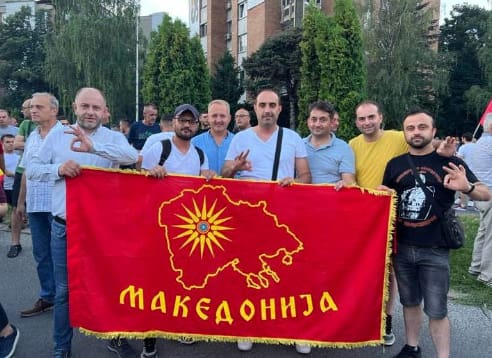
Γράφει ο Δρ. Ιωάννης Αμπατζόγλου*
Νικολάι Ιγνάτιεφ: Η γένεση του Μακεδονικού Ζητήματος
Το Μακεδονικό Ζήτημα δημιουργήθηκε από τους Ρώσους, οι οποίοι μέσω της θεωρίας του πανσλαβισμού και των Βουλγάρων θέλησαν να κατέβουν στο Αιγαίο Πέλαγος. Κομβικό ρόλο σε αυτή την προσπάθεια έπαιξε ο στρατηγός Νικολάι Ιγνάτιεφ, ο οποίος διορίστηκε το 1864 ως πρεσβευτής της Ρωσίας στην Κωνσταντινούπολη1. Με ενέργειες του Ιγνάτιεφ συστάθηκε το 1870 η Βουλγαρική Εξαρχία και το 1878 υπογράφηκε η βραχύβια Συνθήκη του Αγίου Στεφάνου με την οποία η Βουλγαρία επεκτάθηκε μέχρι το Αιγαίο Πέλαγος (Μεγάλη Βουλγαρία). Λίγους μήνες μετά υπογράφηκε η Συνθήκη του Βερολίνου με την οποία αφαιρέθηκαν εδάφη από τη Μεγάλη Βουλγαρία.
Ακολούθησε το 1893 η ίδρυση της αυτονομιστικής οργάνωσης ΒΜΡΟ (ΕΜΕΟ – Εσωτερική Μακεδονική Επαναστατική Οργάνωση) από τους Βουλγάρους με σύνθημα τη φράση «Η Μακεδονία στους Μακεδόνες» και στόχο τη δημιουργία μιας αυτόνομης Μακεδονίας, η οποία μελλοντικά θα ενώνονταν με τη Βουλγαρία2.
Επί κομμουνιστικής Σοβιετικής Ένωσης (διάδοχη κατάσταση της Ρωσίας) αρχικά υποστηρίχτηκε ο μακεδονισμός των Βουλγάρων και στη συνέχεια η ύπαρξη χωριστού μακεδονικού έθνους και μακεδονικής γλώσσας (Κομιντέρν, 1934)3.
Κρστε Μισίρκωφ: Η ιδέα του ξεχωριστού σλαβικού μακεδονισμού
Το 1903 ο Κρστε Μισίρκωφ διατύπωσε για πρώτη φορά την ιδέα ότι ο μακεδονισμός δεν σχετίζεται με τους Βουλγάρους ούτε με τους υπόλοιπους γνωστούς λαούς των Βαλκανίων. Σχετικά μας διαφωτίζει με την εργασία του «Ιστορική επισκόπηση του Μακεδονικού Ζητήματος (1870-1990) – Ανατομία ενός περίπλοκου διαβαλκανικού ζητήματος»4 ο Σπυρίδων Σφέτας, πανεπιστημιακός καθηγητής και μελετητής της βαλκανικής ιστορίας (απεβίωσε το 2021).
Αναφέρει λοιπόν ο Σφέτας ότι ο Κρστε Μισίρκωφ (με καταγωγή από τη Νέα Πέλλα των Γιαννιτσών) υπήρξε ο εμπνευστής του σλαβομακεδονικού έθνους –ως ξεχωριστού έθνους– και ότι ήταν αυτός που εξέδωσε ένα φυλλάδιο το 1903 στη Σόφια της Βουλγαρίας με τίτλο «Για τις μακεδονικές υποθέσεις». Το κείμενο αυτού του φυλλαδίου είναι γραμμένο στη σλαβική διάλεκτο της περιοχής του Μοναστηρίου και αποτελεί το πολιτικό μανιφέστο του κινήματος της αυτονομίας των «Μακεδόνων». Οι «Μακεδόνες» κατά τον Μισίρκωφ δεν είναι Βούλγαροι ούτε ανήκουν σε κάποιο άλλο γνωστό έθνος των Βαλκανίων αλλά αποτελούν ξεχωριστό έθνος με ξεχωριστή γλώσσα.
Γράφει μεταξύ άλλων στο φυλλάδιό του ο Μισίρκωφ: «…Ποτέ δεν υπήρξε μακεδονική εθνότητα, θα μας πουν, ούτε και τώρα υπάρχει. Στη Μακεδονία υπήρξαν και υπάρχουν δύο σλαβικές εθνότητες, οι Σέρβοι και οι Βούλγαροι. Αυτό σημαίνει ότι μια σλαβομακεδονική εθνική αναγέννηση είναι απλά μια κενή δουλειά μερικών φαντασιόπληκτων που δεν έχουν ιδέα της νοτιοσλαβικής ιστορίας. Η Μακεδονία, θα μας πουν κατόπιν οι αντίπαλοί μας, δεν αποτελεί ούτε γεωγραφική ούτε εθνογραφική ούτε ιστορική ενότητα. Ποτέ δεν επέδρασε στις τύχες των γειτονικών λαών, αλλά υπήρξε η κονίστρα του πολιτικού και πολιτιστικού αγώνα μεταξύ των διαφόρων βαλκανικών εθνοτήτων. Τις ίδιες κρίσεις για την πατρίδα μας ίσως να ακούσουμε και από μερικούς συμπατριώτες μας, Μακεδόνες Σλάβους που αποκαλούνται Βούλγαροι, όταν θα εξαντλήσουν όλα τα άλλα μέσα στον αγώνα εναντίον της μακεδονικής εθνικής συσπείρωσης. Στη Μακεδονία δεν υπάρχει γλώσσα, αλλά μονάχα πολλές διάλεκτοι που διαφέρουν μεταξύ τους, αλλά όλες είναι συγγενείς με τις βουλγαρικές διαλέκτους και μ’ αυτές αποτελούν ένα σύνολο, τη βουλγαρική γλώσσα. Άλλες από τις μακεδονικές διαλέκτους είναι πιο κοντά στη σερβική γλώσσα, θα συνεχίσουν τις αντιρρήσεις τους οι αντίπαλοί μας…»
Και ο ίδιος ο Μισίρκωφ αντικρούει τις πιο πάνω αντιρρήσεις με το εξής απλό επιχείρημα: «ό,τι δεν υπήρχε στο παρελθόν, μπορεί να δημιουργηθεί αργότερα, αρκεί να το απαιτούν ιδιαίτερα οι διάφορες ιστορικές περιστάσεις».
Τελικά αποδείχτηκε ότι ο Μισίρκωφ είχε δίκιο. Αυτά που δεν υπήρχαν πριν (το μακεδονικό έθνος ως ξεχωριστό έθνος και η μακεδονική γλώσσα ως ξεχωριστή γλώσσα) δημιουργήθηκαν επειδή το απαίτησαν οι ιστορικές περιστάσεις. Και αυτές οι περιστάσεις είναι τα γεωστρατηγικά συμφέροντα των ΗΠΑ και της Γερμανίας στην περιοχή των Βαλκανίων, σε συνδυασμό με τους πρόθυμους Αριστερούς από την ελληνική πλευρά, δηλαδή τους Τσίπρα, Κοτζιά κ.λπ., που δέχτηκαν να συμβάλουν στη σύνταξη της Συμφωνίας των Πρεσπών, την οποία στη συνέχεια υπέγραψαν και επικύρωσαν. Έτσι, έγινε πραγματικότητα το όνειρο του Μισίρκωφ. Αυτό που δεν υπήρχε πριν από τη Συμφωνία των Πρεσπών το έδωσαν σάρκα και οστά. Δημιούργησαν ξεχωριστό «μακεδονικό έθνος» και ξεχωριστή «μακεδονική γλώσσα» με ελληνική συναίνεση.
Γιόσιπ Μπροζ (Τίτο): Ο ξεχωριστός σλαβικός μακεδονισμός – Από το «Βαρντάρσκα» στο «Μακεδονία»
Το 1944 ο κομμουνιστής ηγέτης της Γιουγκοσλαβίας, Γιόσιπ Μπροζ (Τίτο), μετονόμασε τα Σκόπια από Βαρντάρσκα σε Λαϊκή Δημοκρατία της Μακεδονίας και καλλιέργησε την ιδέα ενός χωριστού και διακριτού μακεδονικού έθνους στην προσπάθεια της περαιτέρω αποβουλγαροποίησής του5,6.
Οι λόγοι που έκανε αυτή την ενέργεια, πέραν του γεγονότος ότι ήθελε να απαγκιστρώσει τα Σκόπια από τη Βουλγαρία, ήταν αφενός για να θεμελιώσει μελλοντικές εδαφικές διεκδικήσεις της Γιουγκοσλαβίας επί των ελληνικών εδαφών (Μακεδονία) και αφετέρου για να εξασφαλίσει διέξοδο στο Αιγαίο. Ήδη από το 1944 ανήγγειλε δημόσια ότι στόχος του ήταν να επανενώσει «όλα τα τμήματα της Μακεδονίας που διασπάστηκαν το 1912 και 1913 από τους βαλκάνιους ιμπεριαλιστές»6.
Για την ιστορία αξίζει να αναφερθεί ότι οι ΗΠΑ δεν αποδέχτηκαν αυτές τις ενέργειες του Τίτο και αντέδρασαν δια του Αμερικανού Υπουργού Εξωτερικών Stettinius, ο οποίος τον Δεκέμβριο του 1944, μεταξύ άλλων έγραψε το εξής: «Η (αμερικανική) κυβέρνηση θεωρεί ότι αναφορές του τύπου “μακεδονικό έθνος”, “μακεδονική Μητέρα Πατρίδα” ή “μακεδονική εθνική συνείδηση” αποτελούν αδικαιολόγητη δημαγωγία που δεν αντικατοπτρίζει καμία πολιτική πραγματικότητα και βλέπει σε αυτές την αναγέννηση ενός πιθανού μανδύα που θα υποκρύπτει επιθετικές βλέψεις εναντίον της Ελλάδας»6.
Νικόλαος Κοτζιάς: Η αναγνώριση του ξεχωριστού σλαβικού μακεδονισμού από την Ελλάδα
Ο τότε υπουργός Εξωτερικών της Ελλάδας κ. Νικόλαος Κοτζιάς (Σεπτέμβριος 2015 – Οκτώβριος 2018) σχεδίασε και ολοκλήρωσε τη Συμφωνία των Πρεσπών στην οποία οι Σκοπιανοί χαρακτηρίζονται «Μακεδόνες» και η γλώσσα τους «μακεδονική». Η συγκεκριμένη συμφωνία έγινε με υπόδειξη των ΗΠΑ και της Γερμανίας μιας και αυτή εξυπηρετούσε τα γεωστρατηγικά τους συμφέροντα στην περιοχή των Βαλκανίων. Βέβαια, υπήρχαν και δύο ακόμα λόγοι που ώθησαν τον κ. Κοτζιά να κάνει αυτή την πράξη.
Ως παλιός κομμουνιστής ήθελε να συνεχίσει το έργο της Σοβιετικής Ένωσης, η οποία υποστήριξε το μακεδονισμό, αρχικά με τη βουλγαρική εκδοχή και στη συνέχεια ως ξεχωριστό μακεδονισμό (Κομιντέρν, ξεχωριστό μακεδονικό έθνος και μακεδονική γλώσσα).
Επίσης, η επιλογή του χωριού Ψαράδες, ως σημείου υπογραφής της Συμφωνίας των Πρεσπών, σχετίζεται με την κομμουνιστική ιδεολογία του κ. Κοτζιά. Το 1949 πραγματοποιήθηκε στους Ψαράδες Πρεσπών το δεύτερο συνέδριο του ΣΝΟΦ (СНОФ, Славјаномакедонски Народно Ослободителен Фронт – Σλαβομακεδονικό Λαϊκό Απελευθερωτικό Μέτωπο). Σε εκείνο το συνέδριο, οι ιδεολογικοί πρόγονοι του κ. Κοτζιά, διακήρυξαν το δικαίωμα της αυτοδιάθεσης του «Μακεδονικού λαού» και ίδρυσαν την ΚΟΕΜ (Комунистичка организација на Егејска Македонија – Κομμουνιστική Οργάνωση της Μακεδονίας του Αιγαίου) ως τμήμα του ΚΚΕ7.
Έτσι, μέσω του κ. Κοτζιά οι ηττημένοι του συμμοριτοπολέμου πήραν το αίμα τους πίσω. Πέραν όμως των ΗΠΑ, της Γερμανίας και των ιδεοληψιών της ελληνικής Αριστεράς, κάτι ακόμα ώθησε τον κ. Κοτζιά να σχεδιάσει και να ολοκληρώσει τη Συμφωνία των Πρεσπών. Αυτό περιγράφεται στο πιο κάτω περιστατικό.
Στις 15-5-2019 ο κ. Κοτζιάς πραγματοποίησε μία ομιλία σχετικά με τη Συμφωνία των Πρεσπών, σε κλειστό ακαδημαϊκό κύκλο στην Οξφόρδη. Κατά τη διάρκεια εκείνης της ομιλίας ανέφερε πάνω από 25 φορές τη φράση «ήθελα να μείνω στην Ιστορία ως ένας πολιτικός που λύνει προβλήματα και όχι που τα διαιωνίζει»8,9,10.
Επομένως, υπήρχαν και λόγοι προσωπικοί, ιδιοτελείς. Ο άνθρωπος αυτός θέλησε να μείνει στην ιστορία μέσω της Συμφωνίας των Πρεσπών. Δεν βρέθηκε κάποιος να του πει ότι και ο Εφιάλτης έμεινε στην ιστορία, όπως επίσης και ο Νενέκος. Δηλαδή τώρα νιώθει υπερήφανος που συμπλήρωσε την τριάδα με τους πιο πάνω αναφερόμενους;
Ο Μισίρκωφ, όπως αναφέρθηκε πριν, έριξε τον σπόρο το 1903 για ένα ξεχωριστό μακεδονικό έθνος και μία ξεχωριστή μακεδονική γλώσσα. Σίγουρα ο σπόρος εκείνος δεν είχε φυτευτεί πολύ βαθιά επειδή ήταν απλά ευσεβείς πόθοι ενός ανθρώπου. Τη σκυτάλη πήρε ο κομμουνισμός για να φτάσουμε στη σημερινή εποχή όπου οι ΗΠΑ και η Γερμανία για τα δικά τους γεωστρατηγικά συμφέροντα έβαλαν μία Αριστερή ελληνική κυβέρνηση (Τσίπρας, Κοτζιάς), 115 χρόνια μετά, να επαναφυτεύσει αυτό τον σπόρο (Συμφωνία Πρεσπών, 2018), σε μεγαλύτερο βάθος αυτή τη φορά, αφού η ελληνική συναίνεση, ότι υφίσταται ξεχωριστό μακεδονικό έθνος και ξεχωριστή μακεδονική γλώσσα, ήταν κομβικής σημασίας.
Χρίστιαν Μίτσκοσκι: Ο σλαβικός μακεδονισμός του VMRO-DPMNE συμπεριλαμβάνει και τους αρχαίους Μακεδόνες
Από τη στιγμή που επικράτησε το VMRO-DPMNE στις διπλές εκλογές των Σκοπίων της 8ης Μαΐου 2024 (προεδρικές και βουλευτικές) περάσαμε στην επόμενη φάση. Αμφισβητείται η Συμφωνία των Πρεσπών από την πρόεδρο των Σκοπίων κ. Γκορντάνα Σιλιάνοφσκα, από τον πρωθυπουργό κ. Χρίστιαν Μίτσκοσκι αλλά και από το σύνολο της νέας κυβέρνησης, επειδή οι πιο πάνω πολιτικοί –όπως και συνολικά το VMRO-DPMNE όλα αυτά τα χρόνια– δεν δέχονται ότι η ονομασία του κράτους τους μπορεί να είναι κάτι άλλο πέραν του σκέτο «Μακεδονία» και επίσης επιθυμούν να έχουν την αποκλειστικότητα του μακεδονισμού. Δεν θέλουν ούτε το «Βόρεια» μπροστά από το «Μακεδονία», ούτε να τους απαγορεύεται να χρησιμοποιούν τον Ήλιο της Βεργίνας, ούτε να αμφισβητείται η καταγωγή τους από τους αρχαίους Μακεδόνες κ.λπ.11,12,13
Ας δούμε όμως τι ακριβώς σημαίνει η ονομασία αυτού του κόμματος. Το αγγλικό ακρωνύμιο «VMRO-DPMNE», γράφεται στα σκοπιανά «ВМРО-ДПМНЕ» και σημαίνει «Внатрешна македонска револуционерна организација – Демократска партија за македонско национално единствo». Στα ελληνικά μεταφράζεται ως «Εσωτερική Μακεδονική Επαναστατική Οργάνωση – Δημοκρατικό Κόμμα για τη Μακεδονική Εθνική Ενότητα». Έχουν πάρει το πρώτο τμήμα του ακρωνύμιου (VMRO) από την οργάνωση που ίδρυσαν οι Βούλγαροι το 1893 και διέλυσαν επίσης οι Βούλγαροι το 1934 και με το DPMNE δηλώνουν ότι επιδιώκουν την «μακεδονική εθνική ενότητα».
Το κόμμα αυτό, ούτε τώρα, ούτε τα προηγούμενα χρόνια έκρυψε τις απόψεις και τις επιδιώξεις του. Ασπάζεται τη θεωρία που λέει ότι οι αρχαίοι Μακεδόνες δεν ήταν Έλληνες, άλλωστε αυτό το αναφέρουν τα σχολικά σκοπιανά βιβλία εδώ και πολλά χρόνια. Κατ’ αυτούς, οι Σλάβοι που κατέβηκαν στην περιοχή της Μακεδονίας αναμείχθηκαν με τους αρχαίους Μακεδόνες και το αποτέλεσμα αυτής της ανάμειξης είναι οι σημερινοί Σκοπιανοί, οι οποίοι είναι οι πιο κοντινοί συγγενείς των αρχαίων Μακεδόνων. Επομένως ως γνήσιοι απόγονοι των αρχαίων Μακεδόνων δικαιούνται να διεκδικούν την ιστορία των προγόνων τους, τα εδάφη τους, τα σύμβολά τους κ.λπ. Δεν είναι τυχαίο ότι ο χαιρετισμός που κάνουν τα στελέχη, τα μέλη και οι ψηφοφόροι του VMRO-DPMNE (συμπεριλαμβανομένης ολόκληρης της ηγεσίας του κόμματος, πρόεδρος, αντιπρόεδροι κ.λπ.) είναι με τον αντίχειρα και τον δείκτη να σχηματίζουν κύκλο και τα υπόλοιπα τρία δάχτυλα ανασηκωμένα, όπως ακριβώς είναι η γνωστή χειρονομία «ΟΚ». Το «Ο» που σχηματίζουν ο αντίχειρας με τον δείκτη, κατ’ αυτούς, συμβολίζει το αρχικό γράμμα της λέξης «Oбединетa» (προφέρεται «Ομπεντίνετα») που σημαίνει «Ενωμένη», ενώ τα τρία ανασηκωμένα δάκτυλα συμβολίζουν τις τρεις «Μακεδονίες», δηλαδή τη «Μακεδονία του Βαρδάρη» (Σκόπια), τη «Μακεδονία του Αιγαίου» (ελληνική Μακεδονία) και τη «Μακεδονία του Πιρίν» (τμήμα της Βουλγαρίας). Με το συγκεκριμένο χαιρετισμό οι Σκοπιανοί δηλώνουν ότι αγωνίζονται για την «Ενωμένη Μακεδονία», η οποία θα επιτευχθεί με την ένωση των τριών πιο πάνω περιοχών («Μακεδονιών») σε ένα κράτος, δηλαδή ούτε λίγο ούτε πολύ έχουν ως στόχο την κατάληψη ελληνικών εδαφών μέχρι και τη Χαλκιδική! Ο χαιρετισμός αυτός αποκαλείται χαιρετισμός της «Ενωμένης Μακεδονίας» (United Macedonia salute)14.
Αφού λοιπόν πήραν οι Σκοπιανοί από τους Έλληνες τη συγκατάθεση, μέσω της Συμφωνίας των Πρεσπών, ότι είναι και αυτοί Μακεδόνες, τώρα με το VMRO-DPMNE διεκδικούν την αποκλειστικότητα στον μακεδονισμό, επομένως και όλα αυτά που αναφέρθηκαν πιο πάνω, τη μακεδονική ιστορία, τα μακεδονικά εδάφη κ.λπ. με απώτερο στόχο τη δημιουργία της «Ενωμένης Μακεδονίας». Δεν ήταν τυχαία η αναφορά που έκανε πρόσφατα η πρόεδρος των Σκοπίων κ. Σιλιάνοφσκα στα «προσφυγόπουλα από το Αιγαιακό τμήμα της Μακεδονίας» και μέσω αυτής επανέφερε τον «μακεδονικό» αλυτρωτισμό κατά της χώρας μας15,16. Η Συμφωνία των Πρεσπών ήταν ο προθάλαμος όλων αυτών των καταστάσεων που ζούμε τώρα.
Τελικά, ο Νικολάι Ιγνάτιεφ αγωνίστηκε για την ιδέα του πανσλαβισμού, ο Κρστε Μισίρκωφ για την ιδέα του ανεξάρτητου σλαβικού μακεδονισμού, ο Τίτο και ο Μίτσκοσκι για το συμφέρον των πατρίδων τους (ασχέτως του παραλογισμού τους ως προς την απαίτηση οικειοποίησης του μακεδονισμού) και ο Νικόλαος Κοτζιάς για τα συμφέροντα των ιμπεριαλιστικών δυνάμεων (ΗΠΑ, Γερμανίας), τις ιδεοληψίες της ελληνικής Αριστεράς και τη ματαιοδοξία του. Ο κ. Κοτζιάς συγκρινόμενος με τους υπόλοιπους είναι ο λιγότερο ιδεολόγος. Είναι ταπεινότερα τα ελατήρια που τον οδήγησαν να κάνει ότι έκανε και πραγματικά αποδείχθηκε κατώτερος των περιστάσεων. Τώρα, ότι, αναφέρει συνεχώς τον εαυτό του ως «Καθηγητή» είναι μία ακόμη απόδειξη ότι ο άνθρωπος είναι «κύμβαλο αλαλάζον» γι’ αυτό κάνει θόρυβο. Αφήστε που σχετικά με τους «Καθηγητές» τα έχει πει μια χαρά ο Μπίσμαρκ (Καθηγητές τρεις κι εχάθη η πατρίς!)
Συνοπτικά τα παραπάνω περιγράφονται ως εξής:
Οι οκτώ (8) βαθμίδες για τη δημιουργία Ανεξάρτητου Μακεδονικού Κράτους, στο οποίο θα συμπεριλαμβάνεται και το έδαφος της ελληνικής Μακεδονίας:
-
Ρωσία – βουλγαρικός μακεδονισμός: Οι Ρώσοι μέσω του Νικολάι Ιγνάτιεφ καταφέρνουν το 1870 να ιδρύσουν τη Βουλγαρική Εξαρχία και το 1878 να υπογραφεί η Συνθήκη του Αγίου Στεφάνου (δημιουργία Μεγάλης Βουλγαρίας). Λίγους μήνες μετά υπογράφεται η Συνθήκη του Βερολίνου με την οποία η Βουλγαρία χάνει εδάφη που είχε λάβει με τη Συνθήκη του Αγίου Στεφάνου. Έτσι δημιουργείται το Μακεδονικό Ζήτημα. To 1893 Βούλγαροι ιδρύουν το VMRO. Οι Ρώσοι στηρίζουν τον βουλγαρικό μακεδονισμό.
-
Μισίρκοφ – ξεχωριστός σλαβικός μακεδονισμός: Ο Κρστε Μισίρκοφ το 1903 διατυπώνει την ιδέα του ξεχωριστού μακεδονικού έθνους και της ξεχωριστής μακεδονικής γλώσσας. Ο μακεδονισμός του Μισίρκοφ είναι ανεξάρτητος από τους Βουλγάρους και από τους άλλους γνωστούς βαλκανικούς λαούς.
-
Κομμουνισμός – βουλγαρικός μακεδονισμός: Η Κομμουνιστική Σοβιετική Ένωση (διάδοχη κατάσταση της Ρωσίας) συνεχίζει να υποστηρίζει τον βουλγαρικό μακεδονισμό.
-
Κομμουνιστική Διεθνής – ξεχωριστός σλαβικός μακεδονισμός: Το 1934 μέσω της Κομμουνιστικής Διεθνούς (Κομιντέρν) ο σοβιετικός κομμουνισμός αναγνωρίζει την ύπαρξη χωριστού μακεδονικού έθνους και μακεδονικής γλώσσας.
-
Τίτο – ξεχωριστός σλαβικός μακεδονισμός, από το «Βαρντάρσκα» στο «Μακεδονία»: Ο κομμουνιστής ηγέτης της Γιουγκοσλαβίας, Τίτο, το 1944 μετονομάζει τα Σκόπια από Βαρντάρσκα σε Λαϊκή Δημοκρατία της Μακεδονίας και καλλιεργεί την ιδέα ενός χωριστού και διακριτού μακεδονικού έθνους.
-
Κοτζιάς – ξεχωριστός σλαβικός μακεδονισμός με ελληνική συναίνεση: Ο Νικόλαος Κοτζιάς το 2018 ολοκληρώνει και υπογράφει τη Συμφωνία των Πρεσπών, η οποία στις αρχές του 2019 επικυρώνεται από την ελληνική Βουλή. Σε αυτή τη συμφωνία, με τη συναίνεση της ελληνικής πλευράς, οι Σκοπιανοί χαρακτηρίζονται Μακεδόνες και η γλώσσα τους μακεδονική.
-
Μίτσκοσκι – ξεχωριστός σλαβικός μακεδονισμός που περιλαμβάνει τη μακεδονική αρχαιότητα: Ο Χρίστιαν Μίτσκοσκι το 2024 κερδίζει τις εκλογές στα Σκόπια με το κόμμα VMRO-DPMNE, αναλαμβάνει πρωθυπουργός και ξεκινάει τη θητεία του με μπαράζ παραβιάσεων της Συμφωνίας των Πρεσπών. Για το VMRO-DPMNE η μακεδονική αρχαιότητα ανήκει στους Σκοπιανούς, επειδή θεωρούν ότι αυτοί είναι οι απόγονοι των αρχαίων Μακεδόνων. Στόχος του συγκεκριμένου κόμματος είναι η δημιουργία μιας «Ενωμένης Μακεδονίας» που θα περιλαμβάνει και το έδαφος της ελληνικής Μακεδονίας.
-
Ανεξάρτητο μακεδονικό κράτος: Στην τελευταία βαθμίδα βρίσκεται η δημιουργία ανεξάρτητου μακεδονικού κράτους, μη ελληνικού, στο οποίο θα συμπεριλαμβάνεται και το έδαφος της ελληνικής Μακεδονίας («Ενωμένη Μακεδονία»). Αυτό θα συμβεί μελλοντικά εάν η Ελλάδα δεν ακυρώσει τη Συμφωνία των Πρεσπών και δεν υπάρξει στη χώρα μας εθνοκεντρική πολιτική.
Ενδεικτικά παρατίθενται μερικές φωτογραφίες ώστε να μην υπάρχει αμφιβολία ότι οι Σκοπιανοί έχουν βλέψεις στα ελληνικά εδάφη.

Ο χαιρετισμός της «Ενωμένης Μακεδονίας». Το μεσαίο από τα τρία ανασηκωμένα δάκτυλα αναγράφει τη λέξη «ЕГЕЈ» που στα σλαβικά σημαίνει «ΑΙΓΑΙΟ» και συμβολίζει την ελληνική Μακεδονία, την οποία οι Σκοπιανοί αποκαλούν «Μακεδονία του Αιγαίου».
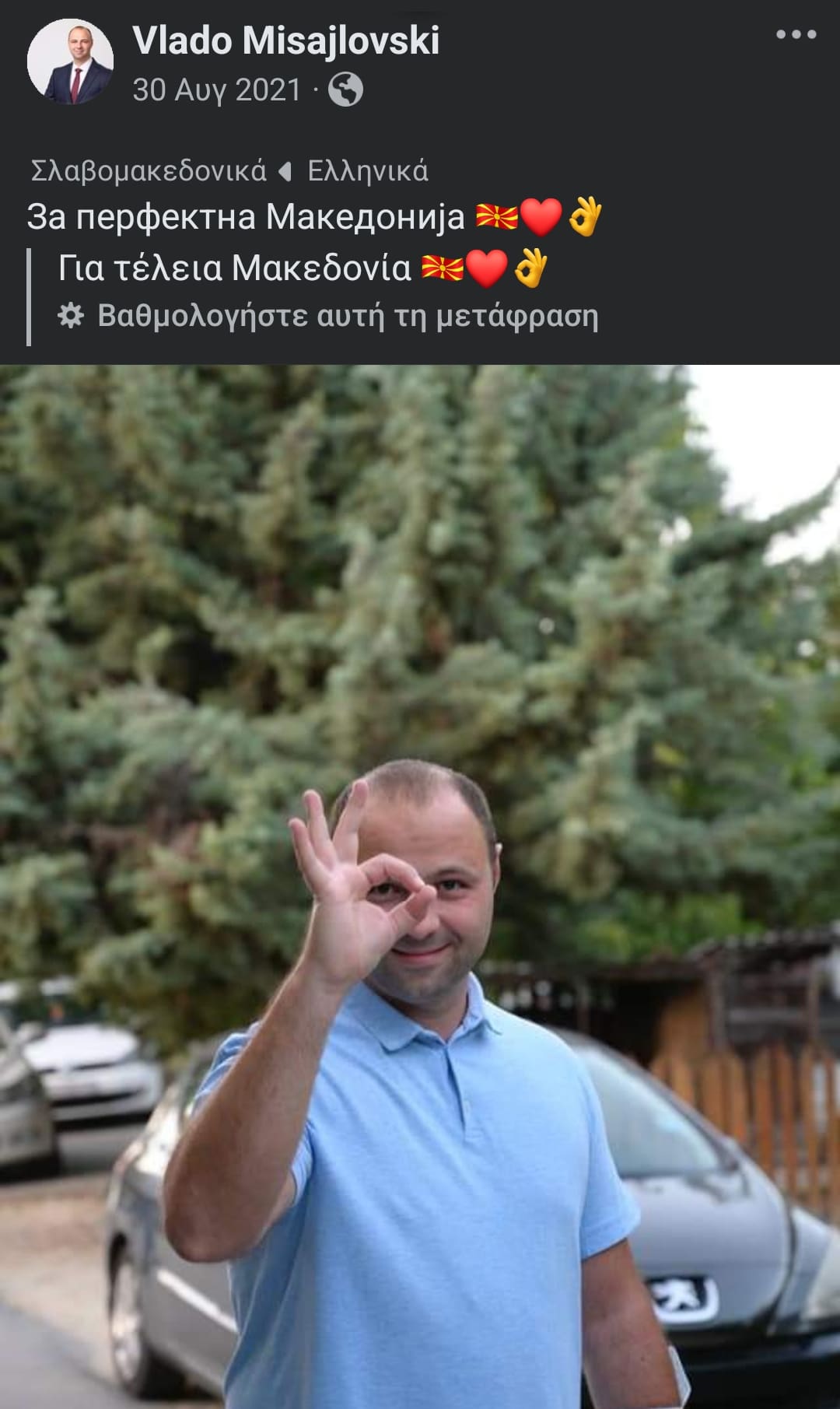
Ο αντιπρόεδρος του VMRO-DPMNE, κ. Βλάντο Μισαϊλόφσκι, τη στιγμή που κάνει τον χαιρετισμό της «Ενωμένης Μακεδονίας» (είναι αυτή που περιλαμβάνει και τη Χαλκιδική) ενώ σχολιάζει με τη φράση «Για μια τέλεια Μακεδονία»17.

Ο πρόεδρος της Ακαδημίας Επιστημών και Τεχνών των Σκοπίων, κ. Λιούπτσο Κότζαρεφ (πέμπτος από αριστερά), στις 4-2-2023, σε εκδήλωση Σκοπιανών στον Καναδά για την 150η επέτειο της γέννησης του Βούλγαρου Γκότσε Ντέλτσεφ. Πίσω του σε τεράστιες διαστάσεις βρίσκονται ο Ήλιος της Βεργίνας και ο χάρτης της λεγόμενης «Ενωμένης Μακεδονίας» (είναι αυτή που περιλαμβάνει και τη Χαλκιδική) στον οποίο αναγράφεται η λέξη «Μακεδονία»18.

Ο δήμαρχος της πόλης Ντεμίρ Χισάρ κ. Νίκολα Ναϊντόφσκι (πρώτος από αριστερά) με μέλη του δημοτικού συμβουλίου του στις 10-7-2022 κατά τη διάρκεια πορείας διαμαρτυρίας στα Σκόπια κάνουν το χαιρετισμό της «Ενωμένης Μακεδονίας» ενώ κρατούν πανό που φέρει τον Ήλιο της Βεργίνας, τη λέξη «Μακεδονία» και χάρτη που περιλαμβάνει τη Θάσο και τη Χαλκιδική19.
1. https://www.antibaro.gr/article/20695
2. https://el.wikipedia.org/wiki/Εσωτερική_Μακεδονική_Επαναστατική_Οργάνωση
3. https://el.wikipedia.org/wiki/Ψήφισμα_της_Κομιντέρν_για_το_Μακεδονικό_Ζήτημα
4. https://www.anixneuseis.gr/ιστορικη-επισκόπηση-του-μακεδονικού/
6. https://www.mfa.gr/to-zetema-tou-onomatos-tes-boreias-makedonias/
7. https://www.dimokratia.gr/apopseis/401057/mia-istoria-tha-sas-po/
8. https://www.antibaro.gr/article/23319
9. https://www.antibaro.gr/article/29195
10. https://www.antibaro.gr/article/33837
11. https://www.epitropiellinismou.gr/post/499
12. https://www.epitropiellinismou.gr/post/2089
13. https://www.epitropiellinismou.gr/post/2261
14. https://en-academic.com/dic.nsf/enwiki/9099277
16. https://x.com/gogamkd/status/1806303063289778322?t=mrnzp4RhgEg4PDMAfb6Q8g&s=19
17. https://www.facebook.com/misajlovskivlado/posts/2624407727866247
18. https://www.facebook.com/groups/203897086311812/posts/6312641085437351/
19. https://x.com/dayastic777/status/1546143107321847810
*Ο Ιωάννης Αμπατζόγλου είναι Ακτινοφυσικός Ιατρικής, διδάκτωρ του Τμήματος Ιατρικής του ΔΠΘ, Επιστημονικά Υπεύθυνος του Τμήματος Ιατρικής Φυσικής του Πανεπιστημιακού Γενικού Νοσοκομείου Αλεξανδρούπολης και Πρόεδρος της Επιτροπής Ελληνισμού.
abadzoglou@yahoo.gr
Video
Γιώργος Αϋφαντής: Στείλτε μήνυμα στο πολιτικό σύστημα!
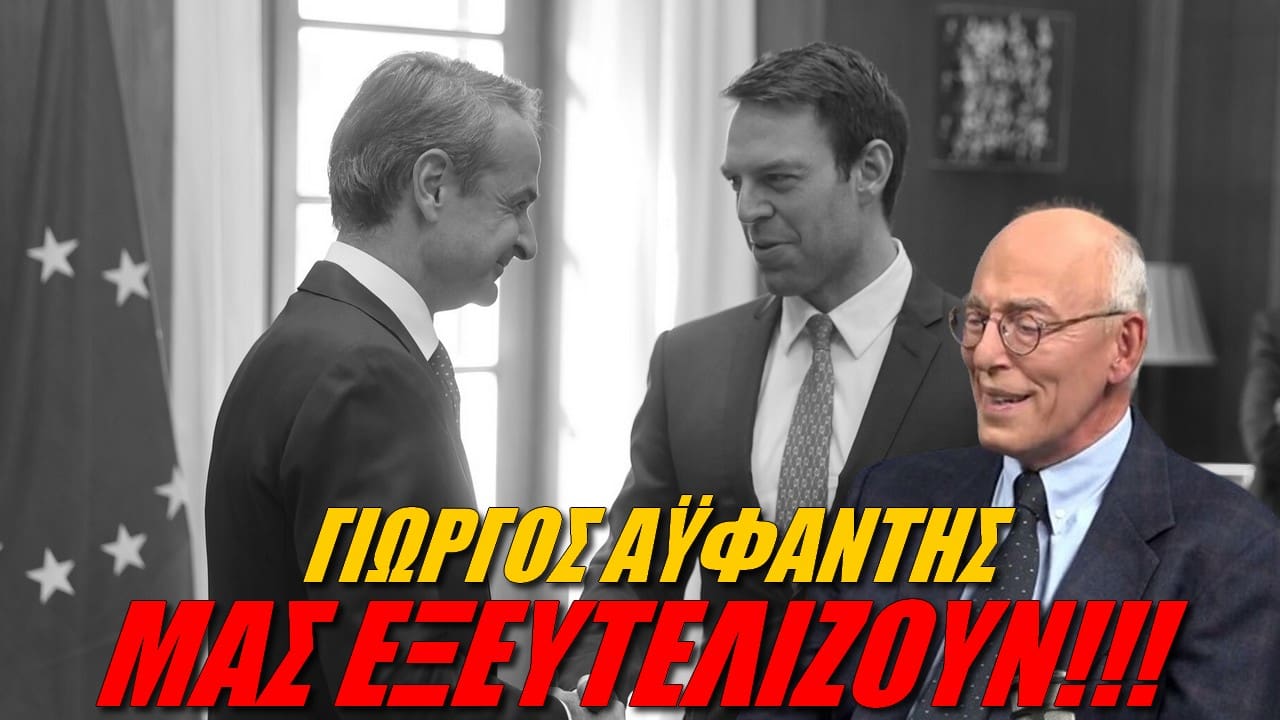
Γιώργος Αϋφαντής: Μας εξευτελίζουν Σκόπια και Αλβανία! Θέλουν να αλλάξουμε τα βιβλία της ιστορίας μας. Σε αυτές τις ευρωεκλογές στείλτε μήνυμα προς το πολιτικό σύστημα.
Εξωτερική Πολιτική
Κίσινγκερ για Μακεδονικό: «Ελάτε κρυφά στις ΗΠΑ να το τελειώνουμε το θέμα…»

(AP Photo/John Duricka)
Άθλια παζάρια στις πλάτες της Μακεδονίας
Τι είχε πει ο Κίσινγκερ στον Κωνσταντίνο Μητσοτάκη κατά τη συνάντηση που είχαν το 1992 στο Νταβός, παρουσία των Γκλιγκόροφ και Αντοφ
Σταύρος Τζίμας
«…Την ώρα που τρώγαμε στο Νταβός, ο Μητσοτάκης μου έδωσε ένα σημείωμα, ένα μικρό χαρτάκι που έγραφε ότι “το μάξιμουμ που μπορεί να δεχθεί με τα σημερινά δεδομένα η Ελλάδα για αυτό το θέμα είναι το Δημοκρατία της Μακεδονίας-Σκόπια, ή παρένθεση ή παύλα, αυτό είναι το μέγιστο”. Το έγραψε σε ένα λευκό χαρτί και μου είπε: “να το δώσεις στον Γκλιγκόροφ και να του πεις ότι ,αν δεν αλλάξετε όνομα, δεν μπορεί να υπάρξει λύση”».
Ήταν αρχές Φεβρουαρίου του 1992 και γύρω από το τραπέζι στο δείπνο, στο πλαίσιο του γνωστού παγκόσμιου οικονομικού φόρουμ στο Νταβός κάθονταν ο Χένρι Κίσινγκερ, ο τότε πρωθυπουργός Κωνσταντίνος Μητσοτάκης και ο στενός συνεργάτης του Κίρο Γκλιγκόροφ, πρόεδρος της βουλής της “Δημοκρατίας της Μακεδονίας” Στόγιαν Αντoφ.
«Ο Μητσοτάκης ήταν επιφυλακτικός για τη συνάντηση μαζί μου. Δεν υπήρχαν μέχρι τότε επαφές. Τέλος πάντων μας “συνάντησαν”. Ο οικοδεσπότης μάς έβαλε, όχι τυχαία, στο ίδιο τραπέζι στο δείπνο. Ο Μητσοτάκης, εγώ και ο Κίσινγκερ. Και τότε ήταν οι πρώτες συνομιλίες ουσιαστικά», μου είπε σε μια εξόχως ενδιαφέρουσα συνέντευξη για την «Κ» (19 Οκτωβρίου 2014) ο ογδοντάχρονος τότε Στόγιαν Αντοφ, παλιός υπουργός του Τίτο εμφορούμενος από τη γιουγκοσλαβική σχολή σκέψης στα ζητήματα της γεωπολιτικής
Η αποσχιση της τότε ΣΔ Μακεδονίας από την καταρρέουσα Γιουγκοσλαβία ήταν νωπή, και μάλιστα οι πολίτες της με συντριπτικό ποσοστό σε δημοψήφισμα είχαν ταχθεί υπέρ της ίδρυσης ανεξάρτητου κράτους υπό το όνομα «Δημοκρατία της Μακεδονίας».
Η ελληνική πλευρά «ψαχνόταν» ως προς την στρατηγική της απέναντι στην εμφάνιση ανεξάρτητου «μακεδονικού κράτους» και εν πολλοίς είχε εναποθέσει τις ελπίδες της στον Μιλόσεβιτς.
Σε αυτήν την ατμόσφαιρα και με τον γιουγκοσλαβικό εμφύλιο να εξαπλώνεται, γύρω από το τραπέζι με τους εκλεκτούς μεζέδες στο χιονισμένο Νταβός, ο Κίσινγκερ, όπως μου είπε ο Αντοφ, πρότεινε στον Μητσοτάκη να συναντηθούν κρυφά στην Αμερική με τον Γκλιγκόρωφ και να τα βρουν «για να τελειώνουμε το θέμα».
«“Κώστα είστε τυχεροί που με την παρουσία αυτού του κράτους απομακρύνονται τα σύνορά σας κατά διακόσια τριάντα χιλιόμετρα από τον πιο επικίνδυνο γείτονά σας, την Σερβία”, του είπε κάποια στιγμή ο Κίσινγκερ. Όταν η κουβέντα ήρθε στις σχέσεις της χώρας μου με την Ελλάδα ο Κισινγκερ επέμενε ότι η Αθήνα πρέπει να μας αναγνωρίσει ως Μακεδονία και να ξεκινήσει μια περίοδος σύσφιξης των σχέσεων. Ο Μητσοτάκης του απάντησε πως αυτό ήταν δύσκολο και ότι το κλίμα στην Ελλάδα δεν ευνοούσε τέτοιες κινήσεις. Του είπε ακόμα ότι υπάρχουν στα Σκόπια κάποιοι που έχουν αλυτρωτικές διαθέσεις και θέλουν να γίνουν κληρονόμοι της ιστορίας της αρχαίας Μακεδονίας. Τώρα που τα βλέπω από απόσταση πολλών χρόνων λέω ότι τα προέβλεψε αυτά ο Μητσοτάκης, τα βλέπουμε μπροστά μας (σ.σ. εννοούσε τα όσα κάνει η κυβέρνηση Γκρουεφσκι). Στην παρατήρηση του Μητσοτάκη ότι κάποιοι κύκλοι θέλουν να σφετεριστούν την ιστορία της Μακεδονίας, ο Κισινγκερ του απάντησε γελώντας: “υπάρχουν αλήθεια τέτοιοι μπουνταλάδες;“. Πάνω στην κουβέντα σε κάποια στιγμή ο Κισινγκερ έριξε μια ιδέα. Απευθυνόμενος σε εμένα μου είπε: “πέστε του κ. Γκλιγκόροφ ότι θεωρώ πως είναι απαραίτητο να συναντηθεί με τον Μητσοτάκη” και γυρίζοντας προς εκείνον του λέει: “Κώστα και εσύ κοίτα να συναντηθείς με τον Γκλιγκόροφ, ελάτε σε εμάς στην Αμερική, θα βρεθεί κάποια ευκαιρία για να έρθετε διακριτικά, με κάποια πρόφαση, και εκεί να συνομιλήσετε και να το τελειώνουμε το ζήτημα αυτό”. Ο Μητσοτάκης του είπε: “δύσκολα-δύσκολα”, αλλά δεν το απέρριψε. Ο Κίσσιγκερ επέμενε η συνάντηση να γίνει υπό πλήρη μυστικότητα – κατ’ εξοχήν αμερικάνικη πρακτική. Τέτοια συνάντηση δεν έγινε. Έκανα σημείωμα στον Γκλιγκόροφ, το βρήκε ενδιαφέρον αλλά δεν έγινε τίποτα. Μετά άλλαξαν οι καταστάσεις…»
Ο Αντoφ, όταν τον ρώτησα σχετικά, υποστήριξε ότι το 1992 δεν υπήρχε από τα Σκόπια διάθεση για υποχώρηση. Ούτε ακόμα και το 93, ενόψει της ένταξης της χώρας στον ΟΗΕ, διαφαίνονταν προθέσεις για συμβιβασμό. Ο Γκλιγκορωφ χειριζόταν ο ίδιος προσωπικά το ζήτημα της ονομασίας και απέφευγε να εξωτερικεύει τις σκέψεις του επ’ αυτού. «Μαζί μιλούσαμε με τις ώρες για το ζήτημα αυτό και κάποιες φορές μου έλεγε ότι κάτι πρέπει να γίνει».
Καθημερινή
-

 Ιράν23 ώρες πριν
Ιράν23 ώρες πρινΚόκκινος συναγερμός στο κεντρικό Ισραήλ! Εκτοξεύτηκε βαλλιστικός πύραυλος από την Υεμένη – Αναχαιτίστηκε με επιτυχία λέει ο IDF
-
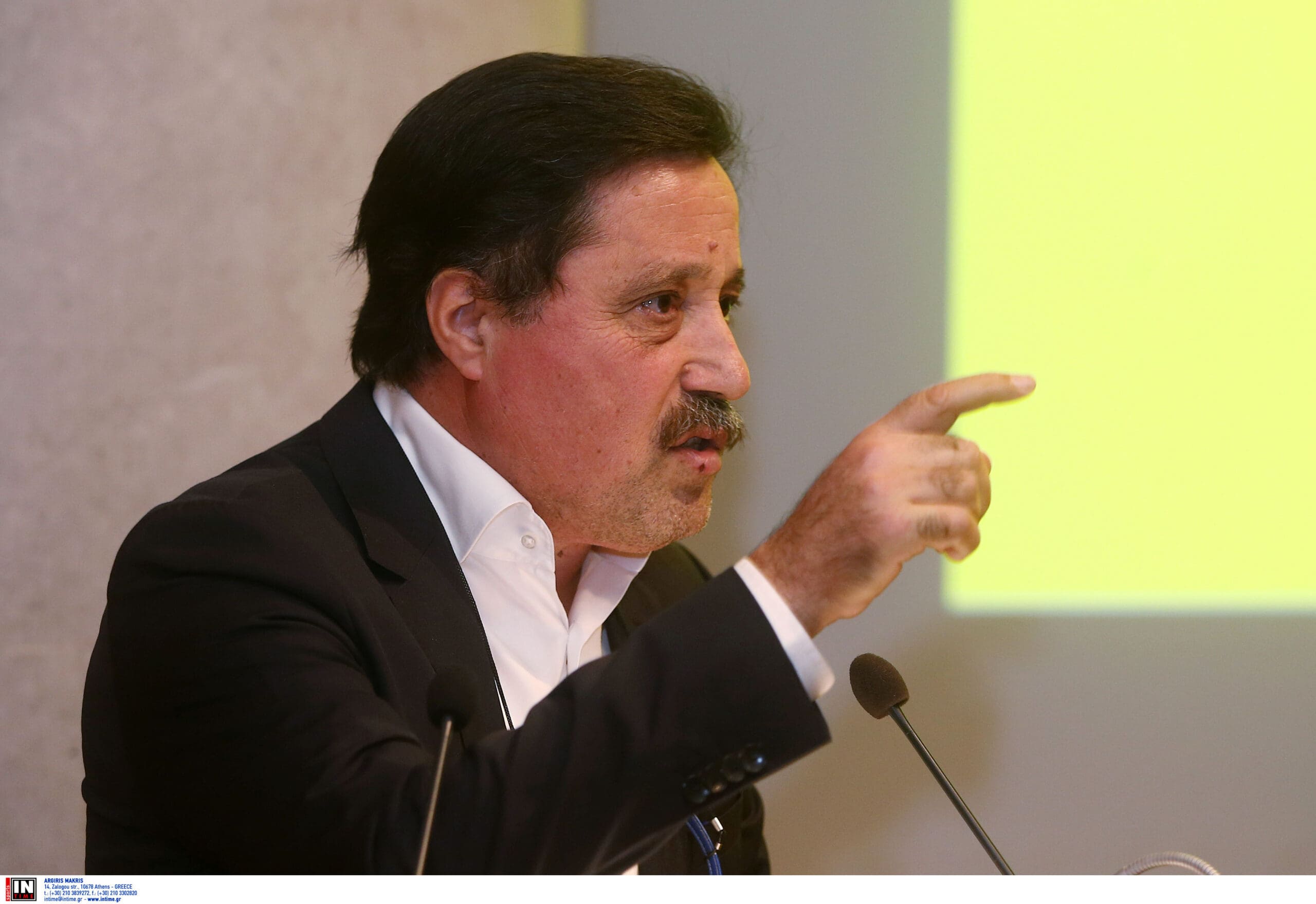
 Video1 ημέρα πριν
Video1 ημέρα πρινΙσραήλ: Αν χτυπήσει πυρηνικά, αρχίζει η καταστροφή
-

 Video1 ημέρα πριν
Video1 ημέρα πρινΑσταμάτητο το Ισραήλ! Βομβάρδισε Ρωσική βάση στην Συρία
-
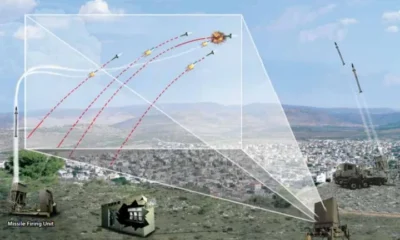
 Εθνική Άμυνα8 ώρες πριν
Εθνική Άμυνα8 ώρες πρινΈτοιμος σε 3 χρόνια ο ελληνικός Σιδερένιος Θόλος! Πόσο θα κοστίσει;
-
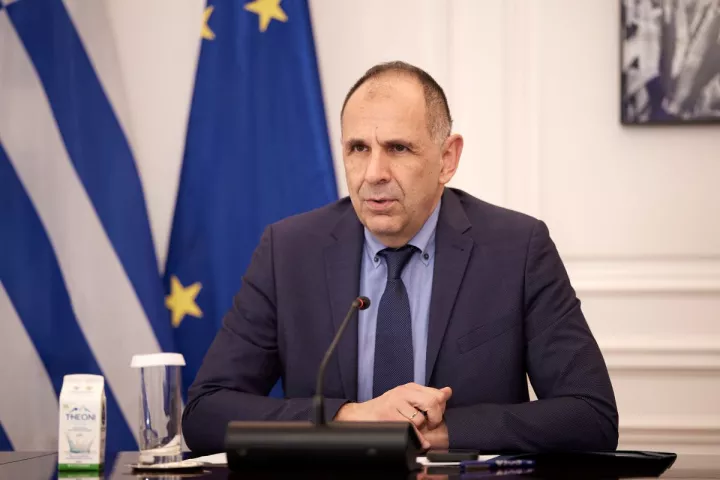
 Αναλύσεις3 ημέρες πριν
Αναλύσεις3 ημέρες πρινQuo vadis κύριε Γεραπετρίτη;
-

 Γενικά θέματα3 ημέρες πριν
Γενικά θέματα3 ημέρες πρινΜία νέα αρχή για το «Γεωπολιτικό»
-

 Ιστορία4 ώρες πριν
Ιστορία4 ώρες πρινΠιέσεις στην Τουρκική Εθνοσυνέλευση να ανοικτούν τα πρακτικά της Δίκης των Ελλήνων που εκτελέστηκαν στην Αμάσεια το 1921
-

 Video1 ημέρα πριν
Video1 ημέρα πρινΣάββας Καλεντερίδης: Δείτε ποιοι μας κυβέρνησαν και ποιοι μας κυβερνούν!










